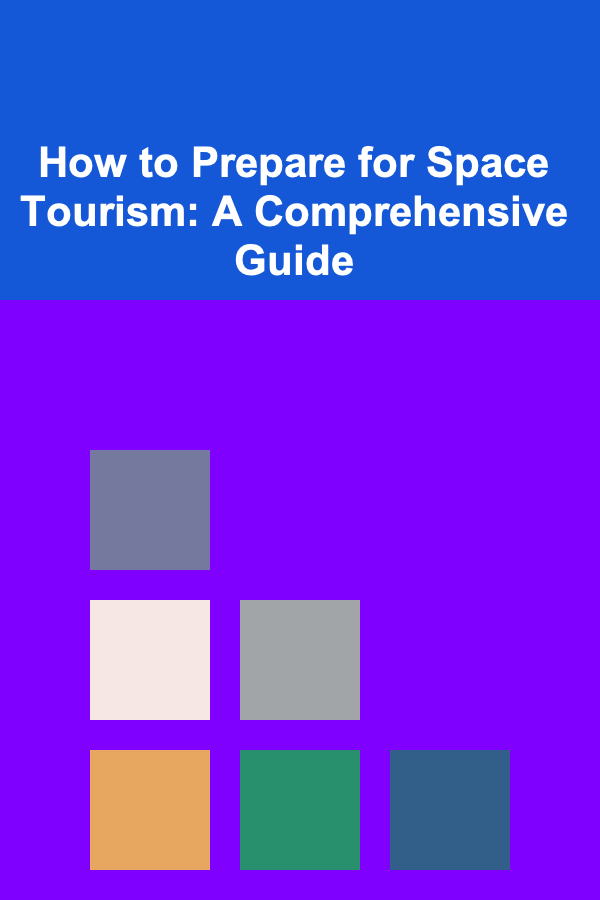
How to Prepare for Space Tourism: A Comprehensive Guide
ebook include PDF & Audio bundle (Micro Guide)
$12.99$11.99
Limited Time Offer! Order within the next:

Space tourism, once a realm of science fiction, is rapidly becoming a tangible reality. As companies like SpaceX, Blue Origin, and Virgin Galactic push the boundaries of space travel, more individuals are presented with the opportunity to experience the awe-inspiring beauty of our planet from beyond the atmosphere. However, journeying to space is not a casual vacation. It requires meticulous preparation, encompassing physical, mental, and financial considerations. This guide provides a comprehensive overview of how to prepare for space tourism, ensuring a safe, enjoyable, and truly unforgettable experience.
I. The Reality of Space Tourism Today
Before diving into the preparation process, it's crucial to understand the current landscape of space tourism. The industry is still in its nascent stages, with distinct differences between the types of experiences offered. These differences significantly impact the required preparation.
A. Types of Space Tourism Experiences
- Suborbital Flights: These flights, typically offered by companies like Virgin Galactic and Blue Origin, involve brief journeys to the edge of space (around 80-100 kilometers above Earth). Passengers experience a few minutes of weightlessness and breathtaking views before returning to Earth. The focus is on the G-forces experienced during ascent and descent, and the brief period of weightlessness.
- Orbital Flights: These more ambitious ventures, spearheaded by companies like SpaceX, involve orbiting the Earth. This experience lasts for several days or even weeks, allowing for extensive viewing of Earth, conducting research, and experiencing prolonged weightlessness. Orbital flights require more rigorous training and preparation due to the longer duration and increased complexity.
- Lunar Missions: While still in the planning stages for civilian tourists, future missions may involve journeys to the Moon, either orbiting or landing on its surface. These missions demand the most extensive preparation, akin to training for professional astronauts.
B. Understanding the Risks and Challenges
Space travel inherently involves risks. Potential challenges include:
- G-Force Exposure: Rapid acceleration and deceleration during launch and re-entry can subject passengers to significant G-forces, potentially leading to discomfort, disorientation, or even, in rare cases, injury.
- Weightlessness: While exhilarating, prolonged weightlessness can cause motion sickness, bone density loss, and muscle atrophy.
- Radiation Exposure: Outside Earth's atmosphere, travelers are exposed to higher levels of radiation, which can pose long-term health risks.
- Confinement: Spending extended periods in a confined spacecraft can lead to psychological stress and social challenges.
- Equipment Malfunctions: While rare, the possibility of equipment malfunction always exists, requiring passengers to be prepared for potential emergencies.
II. Financial Preparation: The Cost of a Dream
The most significant barrier to space tourism for most individuals is the exorbitant cost. It's crucial to have a realistic understanding of the financial implications before embarking on this journey.
A. Budgeting for the Trip
- Flight Cost: This is the primary expense, ranging from hundreds of thousands to millions of dollars, depending on the type of flight and the provider. Suborbital flights generally cost less than orbital or lunar missions.
- Training Costs: Training programs, which are mandatory, are included in the overall price, but it's important to understand the specifics. Some providers may offer additional, optional training sessions at an extra cost.
- Insurance: Securing adequate insurance coverage is essential, especially considering the inherent risks of space travel. This can be a significant expense, requiring careful comparison of different policies.
- Pre- and Post-Flight Medical Expenses: Medical check-ups, vaccinations, and potential post-flight therapies should be factored into the budget.
- Travel and Accommodation: Traveling to and from the launch site and covering accommodation during training can add to the overall cost.
- Contingency Fund: It's wise to have a contingency fund to cover unexpected expenses, such as flight delays, medical emergencies, or the need for additional training.
B. Financing Options
Given the substantial cost, individuals may explore various financing options:
- Personal Savings: The most straightforward option is to utilize personal savings accumulated over time.
- Loans: Securing a personal loan or a secured loan against assets may be an option, but it's crucial to carefully consider the interest rates and repayment terms.
- Investment Returns: Liquidation of investments can provide the necessary funds, but it's essential to consult with a financial advisor to understand the potential impact on long-term financial goals.
- Sponsorships: Individuals with unique skills or backgrounds may seek sponsorships from organizations interested in supporting space tourism.
- Crowdfunding: Platforms like Kickstarter or GoFundMe can be used to raise funds from a wider audience.
III. Physical Preparation: Body as a Spacecraft
The human body undergoes significant stress during space travel. Adequate physical preparation is essential to withstand these challenges and enjoy the experience.
A. Medical Evaluation and Clearance
The first step is a thorough medical evaluation to identify any pre-existing conditions that may be exacerbated by space travel. This typically involves:
- Comprehensive Physical Examination: Assessing overall health and identifying potential risk factors.
- Cardiovascular Assessment: Evaluating heart health and blood pressure to ensure the body can withstand G-forces.
- Pulmonary Function Tests: Assessing lung capacity and function, particularly important for handling changes in air pressure.
- Neurological Examination: Evaluating neurological function to identify any potential issues with balance, coordination, or cognitive function.
- Vestibular Testing: Assessing the inner ear's ability to maintain balance, crucial for adapting to weightlessness.
- Psychological Evaluation: Assessing mental health and stability to ensure the individual can cope with the stress and confinement of space travel.
Individuals with certain medical conditions, such as uncontrolled high blood pressure, severe heart disease, or significant vestibular disorders, may be deemed ineligible for space tourism.
B. G-Force Training
One of the most significant physical challenges of space travel is the exposure to G-forces during launch and re-entry. Training to tolerate these forces is crucial to prevent discomfort, disorientation, or injury. Methods include:
- Centrifuge Training: A centrifuge simulates the effects of G-forces by spinning the individual in a controlled environment. This allows them to gradually build tolerance to the pressure exerted on the body. This is typically offered by the space tourism provider.
- G-Suit Training: G-suits are specialized garments that inflate during acceleration, squeezing the legs and abdomen to prevent blood from pooling in the lower body and reducing the risk of G-LOC (G-force induced loss of consciousness). Training involves learning how to properly use the G-suit and practicing techniques to maintain consciousness.
- Breathing Techniques: Specific breathing techniques, such as the anti-G straining maneuver (AGSM), can help maintain blood pressure and prevent G-LOC during high-G acceleration. Training involves practicing these techniques under simulated G-force conditions.
C. Weightlessness Adaptation
Experiencing weightlessness is one of the most anticipated aspects of space tourism, but it can also present challenges. Training focuses on adapting to this unique environment and preventing motion sickness.
- Parabolic Flights (Zero-G Flights): These flights involve flying in a parabolic arc, creating brief periods of weightlessness. They provide an opportunity to experience the sensation of floating and practice basic maneuvers. These flights are not always included in the initial training and may be an additional expense.
- Underwater Training: Neutral buoyancy tanks simulate weightlessness by suspending individuals in water. This allows them to practice tasks and movements in a three-dimensional environment. While not a perfect simulation, it provides a valuable approximation of the challenges of weightlessness.
- Vestibular Training: Exercises designed to improve balance and coordination can help reduce the risk of motion sickness during weightlessness. These exercises may involve balance boards, spinning chairs, and other specialized equipment.
- Motion Sickness Medication: Consulting with a doctor about appropriate motion sickness medication is advisable. It's important to test the medication before the flight to ensure it's effective and doesn't cause unwanted side effects.
D. General Fitness and Conditioning
Maintaining good overall fitness is crucial for preparing for space travel. A comprehensive fitness program should include:
- Cardiovascular Exercise: Improving heart health and endurance through activities like running, swimming, or cycling.
- Strength Training: Building muscle strength to support the body during G-force exposure and weightlessness. Focus on core strength, leg strength, and upper body strength.
- Flexibility and Balance Training: Improving flexibility and balance to enhance coordination and reduce the risk of injuries. Yoga and Pilates are excellent options.
- Nutrition and Hydration: Maintaining a healthy diet and staying properly hydrated is essential for optimal physical performance. Consulting with a nutritionist can help develop a personalized meal plan.
IV. Mental Preparation: Mind Over Matter
Space travel is not only a physical challenge but also a mental one. Preparing psychologically for the experience is crucial for ensuring a positive and rewarding journey.
A. Stress Management Techniques
The stress of launch, the confined environment, and the potential for unexpected events can take a toll on mental well-being. Developing effective stress management techniques is essential.
- Mindfulness Meditation: Practicing mindfulness meditation can help reduce anxiety and improve focus. It involves paying attention to the present moment without judgment.
- Deep Breathing Exercises: Deep breathing exercises can help calm the nervous system and reduce stress. Techniques like diaphragmatic breathing and box breathing are effective.
- Progressive Muscle Relaxation: This technique involves tensing and relaxing different muscle groups to release tension and promote relaxation.
- Visualization Techniques: Visualizing the experience of space travel can help reduce anxiety and increase confidence. This involves mentally rehearsing the different stages of the journey and imagining a positive outcome.
B. Confinement Adaptation
Spending extended periods in a confined spacecraft can be challenging, especially for individuals accustomed to a lot of space and freedom. Preparing for this involves:
- Spending Time in Confined Spaces: Gradually increasing the amount of time spent in small, enclosed spaces to build tolerance for confinement.
- Developing Hobbies and Activities: Identifying hobbies and activities that can be enjoyed in a limited space, such as reading, writing, or playing games.
- Practicing Communication Skills: Effective communication is crucial for maintaining positive relationships with fellow passengers and crew members. Practicing active listening and assertive communication can help resolve conflicts and build rapport.
C. Emergency Preparedness and Training
While every effort is made to ensure safety, the possibility of emergencies always exists. Understanding emergency procedures and participating in drills is essential.
- Emergency Procedure Training: Learning how to respond to various emergencies, such as fire, cabin depressurization, or equipment malfunction.
- Survival Training: Developing basic survival skills, such as how to use a life raft or administer first aid.
- Communication Protocols: Understanding communication protocols in emergency situations, including how to contact ground control and relay information.
D. Understanding the Cognitive Effects of Space
Space travel can affect cognitive function. Being aware of these potential effects can help manage them.
- Cognitive Training: Participating in cognitive training exercises can help improve memory, attention, and problem-solving skills. This can help mitigate the potential negative impacts of space travel on cognitive function.
- Sleep Hygiene: Maintaining good sleep hygiene is crucial for cognitive function. This involves establishing a regular sleep schedule, creating a relaxing bedtime routine, and avoiding caffeine and alcohol before bed.
- Stress Reduction: As mentioned above, stress can negatively impact cognitive function. Employing stress reduction techniques can help maintain mental clarity.
V. Choosing a Space Tourism Provider: Due Diligence is Key
Selecting the right space tourism provider is a critical step in the preparation process. Thorough research and careful consideration are essential to ensure a safe and enjoyable experience.
A. Safety Record and Technology
The provider's safety record and the reliability of their technology are paramount. Inquire about:
- Flight History: How many successful flights have they conducted? What is their track record of safety?
- Vehicle Design and Testing: What are the key safety features of their spacecraft? How rigorously have they tested their systems?
- Emergency Procedures: What are their emergency procedures? How frequently do they conduct emergency drills?
- Independent Audits: Have they undergone independent safety audits? What were the results?
B. Training Programs and Support
The quality of the training program and the level of support provided are crucial for ensuring a successful journey. Inquire about:
- Training Duration and Content: How long is the training program? What topics are covered?
- Training Facilities and Equipment: What type of training facilities and equipment do they use? Are they state-of-the-art?
- Instructor Qualifications: What are the qualifications of the training instructors? Do they have extensive experience in space travel?
- Medical Support: What medical support is available during training and the flight?
- Psychological Support: What psychological support is available to help passengers cope with the stress and challenges of space travel?
C. Contractual Agreements and Insurance
Carefully review the contractual agreements and insurance policies offered by the provider. Pay close attention to:
- Cancellation Policies: What are the cancellation policies? What happens if the flight is delayed or cancelled?
- Liability Waivers: What liability waivers are required? Understand the extent to which the provider is responsible for injuries or damages.
- Insurance Coverage: What insurance coverage is included in the price? What are the limitations of the coverage?
- Dispute Resolution Mechanisms: What mechanisms are in place for resolving disputes?
D. Customer Reviews and Testimonials
Seek out customer reviews and testimonials to gain insights into the experiences of previous space tourists. Look for:
- Online Reviews: Read reviews on independent websites and forums.
- Testimonials: Contact previous customers directly to ask about their experiences.
- Social Media: Monitor social media for discussions and comments about the provider.
VI. Post-Flight Considerations: Re-Entry to Earth Life
The journey doesn't end with the landing. Post-flight considerations are important for ensuring a smooth transition back to Earth life.
A. Medical Follow-Up
A post-flight medical check-up is essential to assess any potential health effects of space travel. This may involve:
- Physical Examination: Assessing overall health and identifying any new medical conditions.
- Bone Density Scan: Evaluating bone density to detect any bone loss caused by weightlessness.
- Neurological Assessment: Assessing neurological function to detect any cognitive impairments.
- Psychological Evaluation: Assessing mental health and emotional well-being.
B. Rehabilitation and Recovery
Depending on the duration of the flight and the individual's physical condition, rehabilitation and recovery may be necessary. This may involve:
- Physical Therapy: Strengthening muscles and improving balance and coordination.
- Occupational Therapy: Improving functional skills and adapting to daily life on Earth.
- Psychological Counseling: Addressing any emotional or psychological challenges associated with the experience.
C. Sharing the Experience
Many space tourists find it rewarding to share their experiences with others. This can involve:
- Giving Presentations: Sharing their stories and insights with schools, community groups, or professional organizations.
- Writing Articles or Books: Documenting their experiences and reflections in written form.
- Participating in Research: Contributing to scientific research by sharing data and observations.
VII. The Future of Space Tourism
Space tourism is poised for continued growth and innovation. As technology advances and costs decrease, more individuals will have the opportunity to experience the wonders of space travel. Future developments may include:
- Lower Costs: Increased competition and technological advancements may lead to lower flight costs, making space tourism more accessible to a wider range of people.
- More Diverse Destinations: Future missions may involve visits to the Moon, Mars, or other destinations in our solar system.
- Advanced Technologies: New technologies, such as reusable spacecraft and advanced propulsion systems, will improve the safety and efficiency of space travel.
- Personalized Experiences: Providers may offer more personalized experiences, tailored to the individual's interests and abilities.
Conclusion
Preparing for space tourism is a multifaceted process that requires careful planning, significant financial investment, and a commitment to physical and mental conditioning. By understanding the challenges and risks involved, selecting a reputable provider, and dedicating oneself to the necessary training, individuals can maximize their chances of having a safe, enjoyable, and truly transformative experience. While currently limited to a select few, the future of space tourism holds the promise of democratizing access to the cosmos, allowing more people to experience the awe-inspiring beauty of our planet and the vastness of the universe beyond.
Reading More From Our Other Websites
- [Tie-Dyeing Tip 101] Step-by-Step Guide to Your First Tie-Dye T-Shirt
- [Home Holiday Decoration 101] How to Infuse Warmth and Simplicity with Natural Elements in Scandinavian Holiday Decorations
- [Home Staging 101] How to Stage a Home with a Strong Architectural Style
- [Personal Care Tips 101] How to Shave Your Face as a Beginner with a Razor
- [Organization Tip 101] How to Know When It's Time to Replace Your Roof Shingles
- [Organization Tip 101] Jigsaw or Circular Saw? A Guide to Power Tool Versatility
- [Home Cleaning 101] How to Get Rid of Unwanted Odors in Your Home
- [Organization Tip 101] What Tips Can Help You Maintain an Organized Kitchen?
- [Home Holiday Decoration 101] How to Make a Beautiful Holiday Wreath with Simple Materials
- [Home Cleaning 101] How to Clean Your Home Before and After a Move

How to Maximize Your Savings with a Home Budget App
Read More
How to Navigate Divorce and Mental Well-being
Read More
How to Organize Your Laundry Room for Efficient Storage
Read More
Why Organizing Children's Art Projects is Essential
Read More
Understanding Video Compression for the Web
Read More
How to Pack a Picnic for a Large Group
Read MoreOther Products

How to Maximize Your Savings with a Home Budget App
Read More
How to Navigate Divorce and Mental Well-being
Read More
How to Organize Your Laundry Room for Efficient Storage
Read More
Why Organizing Children's Art Projects is Essential
Read More
Understanding Video Compression for the Web
Read More